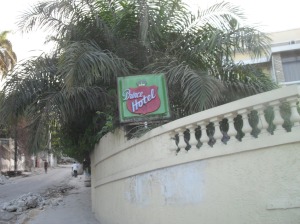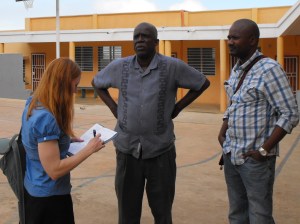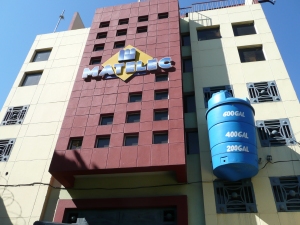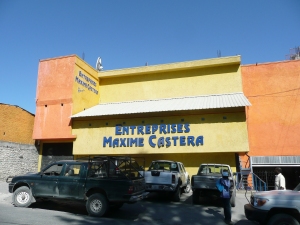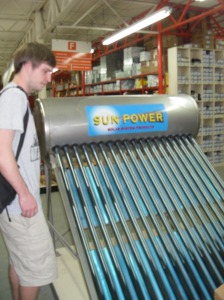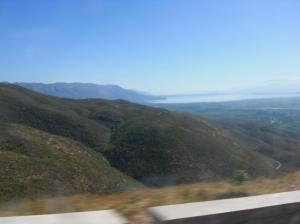Our third day was spent in Port-au-Prince, holding multiple meetings, and going shopping! Well, the shopping mainly involved making price comparisons for solar panels. But it still felt like an adventure.
We started our day with a breakfast meeting at the Prince Hotel, to determine our next steps for the remainder of our trip. We had taken such thorough measurements at the EFACAP school, and had voted unanimously the night before to choose it as our pilot site, we didn’t know whether another trip out to Lascahobas would even be necessary! However, what we learned at the meeting changed our minds, and then our plans, entirely.
First at the meeting, the students had the opportunity to meet Max Larson Henry, who teaches at the State University in Port-au-Prince, and is the consultant to the OLPC project on all things Internet-related. He answered a number of questions we had about Internet connectivity, and why rolling it out is so difficult at present, but may become a reality if the Vietnamese telecom gets approval to cover the country with wireless telephony and eventually broadband Internet services. (Max is pictured below on the right. The photo is from my previous visit.)
Max could only stay for a bit, so we spoke with him first, and then moved on to the subject of what we would do for the rest of the trip. We told Guy Serge, the university students, and the two others from the OLPC offices that we had decided on the EFACAP school, even though we had been thoroughly impressed by the sisters at the Catholic school, and their commitment to the project. In turn, the OLPC staff described how the Catholic school was indeed very supportive of the project, accommodating of the changes required to make use of the laptops in the classroom…and had other good things to say about them. Next, they went on to emphasize how the Baptist school staff was even more enthusiastic about the OLPC project, and how much initiative and creativity they had demonstrated in the use of the XOs at their school…and that it was a shame that the best choice structurally for us was the worst choice inter-personally.
They were unanimous about this. Every single person in the group was familiar with the inter-personal relations and added his own thoughts on the matter. It didn’t take more than a minute for our group to vocalize that the engineering solution is not the entire picture, and that the human, social, inter-personal factors are far more important. (I was so proud!)
So, we decided we’d need another trip to Lascahobas, to do a proper site survey of the two schools we’d written off the day before. The perfect example of how the engineering solution is a necessary but insufficient condition for solving an engineering problem! The human factor matters a great deal more.
We would go to Lascahobas that evening and stay overnight, so we could get an early start on our measurements and calculations during our second visit.
To make the most of the rest of the day, we split into two groups and raced around the capital city, visiting every store that was deemed a possible candidate for selling solar panels, batteries, wiring, etc.
My group was successful, finally, at the last store we visited.
After our shopping adventure, we returned to OLPC headquarters, where we had a meeting with a local solar expert/consultant we could work with in the future.
He has done a number of solar installs around the country. However, he had not considered the DC-only solution we were proposing. He seemed interested in and open to working with us, should the possibility arise in May. His point of view was that we should use German solar panels, since they come with a 25-year warranty (whereas the best warranty one can find in Haiti otherwise is for 1-year!) He admitted that they would cost more, and perhaps considerably more, but that they were worth it—both the quality of the panels and the 25-year warranty were worth the extra money. We decided we will try to negotiate with any companies, German or otherwise, for a donation of solar panels, with the hope/promise of a scaled-up-sized purchase in the future, if and when our lower cost, open source design becomes widely accepted. Of course, I’ll keep this posting updated regarding that endeavor!
After our meeting with the local solar expert, we were treated to a delicious “traditional” Haitian meal that one of the students, Delbeau, had kindly offered to bring back to the office, so we could all eat together. We were given a choice of meat, and everyone gamely opted for goat. I thought it was delicious!
After this very late lunch, we hit the road for Lascahobas—or actually, Mirebalais, and eventually made it to the Wozo Plaza Hotel, where yes, there were peacocks.
Since we got such a late start leaving Port-au-Prince, this drive was made mostly in the dark, which introduces a whole new level of excitement to the Haitian driving that could never be called boring to begin with. Once we finally made it safely to the hotel, hijinks (mainly of an arachnid nature) awaited us, but I will honor the next post with that story.

